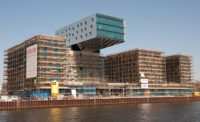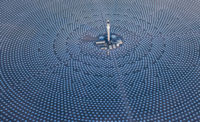“Can a building operate without even being on a grid?” asked Patrick Phelan to a packed room at Arizona State University’s Julie Ann Wrigley Global Institute of Sustainability Friday April 1 for his presentation, “Buildings of the Future” for the school’s Sustainability Series.
Phelan has been an ASU faculty member since 1996 but is currently on leave from Arizona State University to assist the U.S. Department of Energy in an applied R&D program that focuses on energy efficiency in buildings. He recently took part in the Sustainability Series to share his research and vision of environmentally-conscious buildings of the future.
The presentation began with the the audience “imagining buildings” that will improve upon the environment and Phelan asking attendees to “think outside the box.”
Thinking outside of the box is what Phelan does at the Department of Energy. In partnership with Nora Wang, senior engineer at Pacific Northwest National Laboratory, Phelan is looking at what happens after the infrastructure in the country hits carbon zero. Wang was slated to join Phelan but could not make the trip for medical reasons.
“[We are not just writing] a report on what future buildings should be,” Phelan says. “We’re not trying to forecast the future, but the desired end point.”
He admits that the golden age of sustainable buildings is still a ways away, noting that right now the U.S. isn’t “anywhere close to our ideal.” For example, 40% of energy consumption in the country comes just from buildings. That’s more than the transportation and industrial sectors. The reason? Buildings use a ton of electricity. Or perhaps more accurately, people use a ton of energy. But Phelan and Wang project in their study that energy intensity consumption is going down because buildings are being built better than ever.
The point of the research is to show that if humans really want zero emission buildings, they can have them. Phelan and Wang are focusing, as of the time of the lecture, on 14 metrics including biodiversity using the Simpson index, water consumption and energy consumption.
Phelan explains the study is aimed at defining the targets for the future and where consumers are today. He is poised to track the environmental impact of not just buildings but the people in them.
“We are trying to get a view of a well controlled future… however undefined that is,” Phelan says.
Phelan explains that the team’s work is not just about making buildings more energy efficient, though surely that’s a big part of it. “This goes beyond LEED certified,” he says and stresses really, it’s about humans adopting new behaviors.
“When LEED buildings fail it’s because of humans,” Phelan says, but adds that his study with Wang has “yet to address human behaviors.” He promises, “That’s part of next year’s study.”
An audience member asked about social equity and whether or not the research takes it into account. “That’s also important,” he says, “But social equity will not be addressed in the study at this time… for mostly political reasons.”
Phelan believes that buildings of the future will be optimized; they’ll make the most of resources like water and energy, but they will also be primarily multifunctional, programmable and adaptable. “They’ll be easy to reconfigure and upgrade,” he says, but it’s an integrated vision. Even Phelan admits, “How do you measure what a good building is?”
His study is still trying to find out.
Phelan does note, however, that the top two factors shaping the future-built environment are advancement in materials and energy market changes. “We can ask more from our buildings than ever before,” he says. In the end, “it will not just be about the building. It will be about a higher quality of life.”
Stephanie Sparer contributed to this report.




Post a comment to this article
Report Abusive Comment